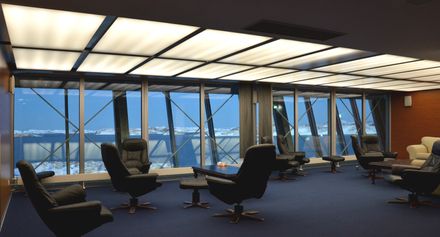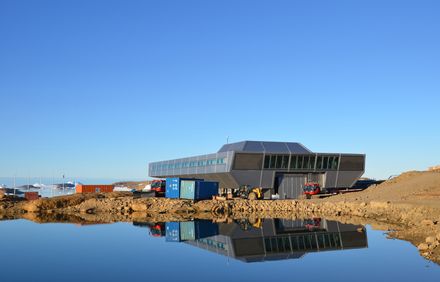
Indian Research Base
YEAR
2013
LOCATION
Ecuador
CATEGORY
Research
Text description provided by architect.
The team of planners including Bof Architects (Hamburg), IMS Ingenieurgesellschaft (Hamburg) and m+p consulting (Brunswick) was able to win an open competition for the new construction of the Indian polar station in the Antarctic in December 2006.
The contract was awarded by the National Center for Antarctic and Ocean Research (NCAOR) and planning commenced in spring of 2009.
The planning was conducted primarily in Hamburg and the coordinating meetings with the client were conducted every two months with the client in Goa, India.
During the winter of 2010/2011 the infrastructural measures for the site were executed including the helipad, the pipelines and the kerosene tanks etc. The actual polar station structure was assembled during the winter of 2011/2012.
The location of the station is on a peninsula in the Larsmann Hills region in the northeast section of the Antarctic. The extreme climate conditions and the limited means of transportation required a special architectural solution in regards to the existing circumstances. Central aspects in regards to the project include the following: redundancy, sustainability and mobility.
Due to the restricted accessibility to the region and considering the stipulations of the Antarctic Treaty, the station must be completely self-sufficient and constructed in a manner that allows for a complete disassembly.
The building is outfitted with a self-sufficient source of energy, heating and cooling systems and its own fresh water treatment system. The combined heat and power unit provides the energy for the station.
The residual heat resulting from the production of electricity is more than sufficient to heat the entire station.
The CHP unit and all other elements of the construction required for living purposes are conceived in such a manner, that in the event an element should malfunction, a substitute element is available on site.
The building consists of 134 standard shipping containers that not only define the individual spaces, but which also account for the structural system. The high degree of mobility and flexibility associated with such containers provides for an optimal means of transport and extremely short assembly periods.
The functions of the building are clearly structured and organized. A total of 24 single and double rooms are located on the second floor as is a kitchen and dining room, a library, a fitness room, an OP room, as well as the offices and a lounge.
The lower level houses the laboratories and the storage spaces, the technical spaces, the CHP unit as well as the garage which includes a workshop. The third level houses the air conditioning system as well as the terrace which can be used for diverse scientific experiments.
Due to the extreme conditions in the Antarctic, the extremely low temperatures and the powerful winds, the containers have been clad with an insulated, aerodynamic skin consisting of metal panels. The form of the facade was tested in a wind canal and was optimized for this purpose.
The primary goal was to minimize the build up of snowdrifts around the building to eliminate the chances of being snowed in.
Additionally the effects of wind loads on the facade had to be reduced to a minimum. The ends of the stations are generously glazed and offer panoramic views of the ice and the sea from the dining room and the lounge.
The interior of the station is characterized by wood, diverse colors and ample daylight, all of which account for a comfortable workplace and a high quality sojourn.
During the summer months the station can house approximately 47 researchers and scientists and approximately 24 members during the winter.
The station, including a mock-up, was prefabricated in Duisburg during the summer of 2011. Subsequently the individual elements were shipped by way of Antwerp and Cape Town to the Antarctic for assembly purposes.



























